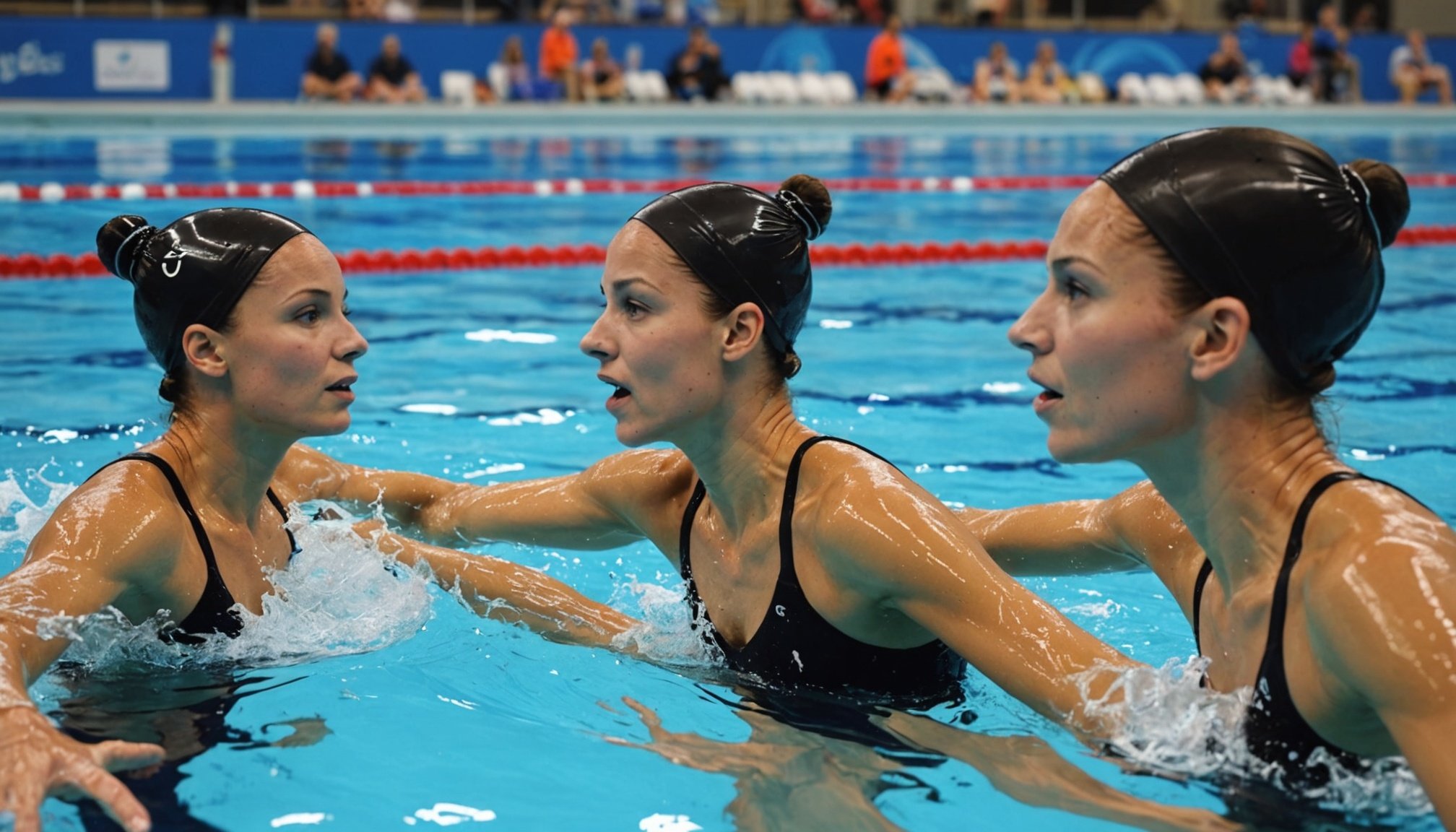Importance of Breath Control in Synchronized Swimming
In synchronized swimming, mastering breath control is crucial for peak performance, both physiologically and aesthetically. Breath control directly affects an athlete’s stamina and endurance underwater, allowing them to hold their breath for extended periods while performing intricate movements. This aspect not only preserves energy but also enhances underwater performance, a vital component when executing moves beneath the surface.
Effective breath control helps swimmers remain in perfect sync with their teammates. Timing breath holds precisely with routine movements ensures that each swimmer’s actions are mirrored flawlessly. It offers a silent, unifying rhythm, which is essential for dazzling group performances and is key to achieving harmony in the water.
Also read : Mastering endurance: essential strategies for rowers to dominate long-distance competitions
Moreover, superior breath control contributes significantly to the visual and artistic elements of synchronized swimming. It enables smoother transitions between complex figures and facilitates a more elegant and flowing routine. The audience and judges are often captivated by the effortless grace exuded by swimmers who maintain impeccable breath control, elevating the performance’s artistic impression. As such, synchronized swimmers must diligently practice breath control to excel competitively and aesthetically in their performances.
Advanced Techniques for Mastering Breath Control
Developing effective breath techniques is crucial for synchronized swimmers striving to enhance their underwater skills. Utilizing these techniques maximizes oxygen intake and optimizes your performance.
Topic to read : Mastering the art of spins: elevate your ice skating with targeted strength training strategies
Diaphragmatic Breathing
Diaphragmatic breathing involves engaging the diaphragm to maximize lung capacity. This technique allows synchronized swimmers to take deeper breaths, translating to increased energy and endurance. Unlike shallow chest breathing, diaphragmatic breathing requires practice but results in significant performance improvements underwater, where maintaining oxygen levels is critical.
Controlled Exhalation
Controlling your exhalation aids in sustaining longer breath holds, essential for synchronization. By releasing air slowly and deliberately, swimmers can manage their oxygen usage effectively. This technique ensures that athletes conserve air, allowing them to perform complex routines more efficiently.
Breath Timing Strategies
Timing breath holds with synchronized movements is paramount in achieving optimal performance. Swimmers must practice coordinating breath with music cues and choreography. Mastery in this area facilitates uninterrupted routines, ensuring seamless transitions and precise movements. This alignment plays a pivotal role in maintaining group harmony and can be practiced through targeted drills that simulate performance conditions. By honing these techniques, synchronized swimmers can elevate their routines, balancing athleticism and artistry in perfect harmony.
Drills and Exercises to Enhance Breath Control
Enhancing breath control in synchronized swimming is vital for peak performance and aesthetic appeal. Breath exercises are essential components of a swimmer’s training regimen, focusing on building both capacity and endurance.
Engaging in specific training drills can notably improve breath retention. Swimmers can practise holding their breath at intervals while performing simple strokes to simulate routine conditions. This drill sharpens endurance and provides practical experience in managing airflow.
Incorporating equipment such as fins can add an element of resistance training. The use of fins increases effort underwater, strengthening the respiratory muscles essential for effective breath control. This training method offers a dual benefit by enhancing leg strength and developing breathing capabilities.
Routine practice sessions should integrate these breath control exercises for optimum performance enhancement. Introducing breath-focused drills into the regular training schedule ensures the athletes strengthen and refine their breath control, ultimately contributing to better synchronization and execution of complex routines.
By rigorously practicing these methods, swimmers will enhance their performance, harmonising their breath with movements to achieve excellence in competitive environments. Consistent training in these areas holds the key to excelling in both the athletic and artistic facets of synchronized swimming.
Tips for Maintaining Breath During Performance
Achieving routine excellence in synchronized swimming requires staying composed and mastering breath control, even under competitive pressure. Implementing effective performance tips is crucial for success.
Visualisation techniques and a well-established pre-performance routine can combat anxiety that interferes with breath control. Visualising each routine step enhances focus and calms the mind, promoting confidence. Athletes should practice visualisation during training, making it an integral part of their mental preparation to foster habitual relaxation.
Strategies for remaining relaxed throughout a performance include deep, steady breathing and maintaining mindful awareness. Incorporating breaks to consciously breathe deeply can prevent panic and help maintain breath control, especially during more intense segments.
Routine excellence relies on managing anxiety through familiarisation with the performance environment. Athletes often benefit from mental rehearsals of their routine under varied conditions, ensuring adaptability.
For competition success, it’s vital to develop skills for overcoming performance nerves. Relaxation techniques such as progressive muscle relaxation can reduce pre-performance jitters. By mastering these techniques, synchronized swimmers can maintain breath control, supporting seamless transitions and ensuring victorious execution on the international stage.
Expert Insights on Breath Control in Synchronized Swimming
Delving into the world of synchronized swimming, expert perspectives enrich the understanding of breath control. Through athlete testimonials, swimmers reveal the nuanced breath control strategies that elevate their routines. Elite athletes often attribute peak underwater performance to meticulous practices, emphasizing deep breathing exercises and precise timing in conjunction with team movements.
Interviews with Elite Synchronized Swimmers
In interviews, champions share personal techniques honed to perfection. They stress the importance of integrating breath control seamlessly into choreographed routines, ensuring each breath aligns with the team’s intricate movements. Swimmers highlight how maintaining composure and synchrony underwater translates directly to competitive success.
Coaching Perspectives on Breath Control
Coaches adept in training athletes underscore the necessity of breath control in synchronized swimming. They recommend structured breath control exercises tailored to enhance oxygen management. Coaches also advise regular feedback sessions where routines are scrutinized for breath timing, further refining athletes’ performances.
Case Studies of Successful Competitors
Studying the routines of past synchronized swimming champions offers invaluable insights. Analysis reveals that disciplined breath control leads to awe-inspiring performances. These case studies underscore how mastering breath techniques can propel swimmers towards achieving performance excellence, showcasing both athletic prowess and artistic grace.
Visual Aids and Examples
Visualizing breath control techniques enhances understanding and application for synchronized swimmers. Using video clips effectively demonstrates how elite performers maintain breath control during complex routines. For instance, analyzing a routine’s slow-motion playback can reveal the subtle synchronization between breath timing and graceful moves. This allows swimmers to identify precise moments to inhale or exhale, aligning perfectly with their underwater performance.
Infographics serve as invaluable tools for illustrating key techniques and exercises. These visuals break down complicated concepts into understandable, digestible elements, helping athletes grasp them more thoroughly. Infographics can highlight the anatomy and benefits of diaphragmatic breathing, controlled exhalation strategies, or showcase drills aimed at improving breath retention.
The breakdown of performances through detailed analysis provides insights into how competitors optimize their performance through breath control. This approach not only aids current athletes in learning best practices but also challenges them to transcend their current limits. By reviewing successful synchronization, swimmers can mimic and adapt these polished techniques, integrating them into their training. Embracing these resources allows for a deeper comprehension and mastery of breath control techniques that propel swimmers towards greater artistic and athletic accomplishments.











